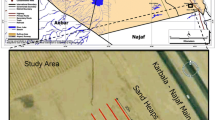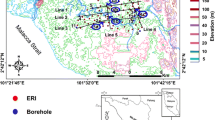Abstract
A non-symmetrical azimuthal resistivity survey was applied with three different types of electrode arrays (Wenner, Schlumberger and polar dipole–dipole arrays) at two sites near water wells contaminated with hydrocarbon materials in order to determine the flow direction of movement of a hydrocarbon mass in the unsaturated zone. A subsurface plume of hydrocarbons was determined to be moving in a north-easterly direction. It is found that all the used arrays showed the ability to delineate the extent of the hydrocarbon mass, but polar dipole–dipole array was the best method to delineate the exact axis of the plume in the unsaturated zone. A symmetrical azimuthal resistivity survey with a Wenner electrode array was applied in four stations near contaminated well 8 in order to detect the flow direction of contaminated groundwater from a spill from the well. This technique gave good results in detecting the flow direction and showed that the bulk of the contamination moved in a north-westerly direction. Contamination from this source then divided into two parts, with a major part moving a north-easterly direction, and the second part moving to the south-west. This work has indicated that resistivity techniques can be successful in determining the direction of flow of hydrocarbons in the unsaturated zone under suitable conditions.









Similar content being viewed by others
References
Allen JP, Atekwana EA, Atekwana EA, Duris JW, Werkema DD, Rossbach S (2007) The microbial community structure in petroleum-contaminated sediments corresponds to geophysical signatures. Appl Environ Microbiol 73(9):2860–2870
AL-Menshed FH (2011) Evaluation of resistivity method in delineation ground water hydrocarbon contamination southwest of Karbala city. Ph.D. Thesis, Dept. of Geology, College of Science, University of Baghdad, p 210
Andres KG, Canace R (1984) Use of the electrical resistivity technique to delineate a hydrocarbon spill in the coastal plain deposits of New Jersey. In: Proceedings of the NWWA/API conference on petroleum hydrocarbons and organic chemicals in ground water-prevention, detection and restoration, Houston, pp 188–197
Atekwana EA, Atekwana EA, Rowe RS, Werkema DD, Legall FD (2004) The relationship of total dissolved solids measurements to bulk electrical conductivity in an aquifer contaminated with hydrocarbon. J Appl Geophys 56:281–294
Ben OI, Onwuemesi AG (2009) Estimation of anisotropic properties of fractures in Presco campus of Ebonyi State University Abakaliki, Nigeria using Azimuthal resistivity survey method. J Geol Min Res 1(8):172–179
Boadu FK, Gyamfi J, Owusu E (2005) Determining subsurface fracture characteristics from azimuthal resistivity survey: a case study at Nsawam, Ghana. Geophysics 70:B35–B42
Delgado-Rodríguez O, Shevnin V, Ochoa-Valdés J, Ryjov A (2006) Geoelectrical characterization of a site with hydrocarbon contamination caused by pipeline leakage. Geofísica Internacional 45(1):63–72
Hagrey SA (1994) Electric study of fracture anisotropy at Falkenberg, Germany. Geophysics 59:881–888
Hassan KM, Al-Khateeb AAG, Khlaif HO, Kadhum MA, Saeed FS (2002) Detailed geological survey for mineral exploration in Karbala—Najaf area. Part 1, Geology. GEOSURV, Int. Rep. No. 2874
Kunetz G (1966) Principle of direct current resistivity prospecting. Borntrager, Berlin, p 106
Leonard MPJ (1984). A surface resistivity method for measuring hydrologic characteristics of jointed formations, U.S. Bur. Mines Report of Investigations 8901
Mazáč O, Benes L, Landa I, Maskova A (1990) Determination of the extent of oil contamination in groundwater by geoelectrical methods. Geotechnical and environmental geophysics. vol 2. Society of Exploration Geophysics, Tulsa, pp 107–112
Nunn KR, Barker RD, Bamford D (1983) In-situ seismic and electrical measurements of fracture anisotropy in the Lincolnshire chalk. Q J Eng Geol 16:187–195
Ritzi RW, Andolsek RH (1992) Relation between anisotropic transmissivity and azimuthal resistivity surveys in shallow fractured carbonate flow systems. Groundwater 30:774–780
Sadowski RM (1988) Clay-organic interactions. M.Sc. Thesis, Dept. of Geochemistry, Colo. School of Mines, Golden, p 209
Sauck WA (1998) A conceptual model for the geoelectrical response of LNAPL plumes in granular sediments. Proc Symp Appl Geophys Eng Environ Prob 11:805–817
Sauck WA (2000) A model for the resistivity structure of LNAPL plumes and their environs in sandy sediments. J Appl Geophys 44:151–165
Shevnin V, Delgado-Rodríguez O, Mousatov A, Nakamura-Labastida E, Mejia-Aguilar A (2003) Oil pollution detection using resistivity sounding. Geofísica Internacional 42(4):613–622
Shevnin V, Delgado-Rodríguez O, Fernández-Linares L, Martínez HZ, Mousatov A, Ryjov A (2005) Geoelectrical characterization of an oil-contaminated site in Tabasco, Mexico. Geofísica Internacional 44(3):251–263
Skyernaa L, Jorgensen NO (1993) Detection of local fracture systems by azimuthal resistivity surveys: example from south Norway: memoirs of the 24th congress of International Association of Hydrogeologists pp 662–671
Slater LD, Wishart DN, Gates EA (2006) Self potential improves characterization of hydraulically-active fracture from azimuthal geoelectrical measurements. Geophys Res Lett 33:L17314
Taylor RW, Fleming AH (1988) Characterizing jointed systems by azimuthal resistivity surveys. Ground Water 26:464–474
Thabit JM, Khalid FH (2016) Resistivity imaging survey to delineate subsurface seepage of hydrocarbon contaminated water at Karbala Governorate, Iraq. Environ Earth Sci 75(1):1–7
Waxman MH, Thomas EC (1974) Electrical conductivities in shaly sands. I. The relation between hydrocarbon saturation and resistivity index. II. The temperature coefficient of electrical conductivity. J Petrol Tech Trans AIME 257:213–225
Acknowledgments
The authors would like to thank the general director of General Commission for Groundwater (Mr. Dhafir Abdullah) and investigations department staff for providing requirements for achieving the field work and helping me with necessary information about the studied area and the contaminated wells.
Author information
Authors and Affiliations
Corresponding author
Rights and permissions
About this article
Cite this article
AL-Menshed, F.H., Thabit, J.M. The use of an azimuthal resistivity survey to detect the flow direction of hydrocarbons in the unsaturated zone at Karbala Governorate, Iraq. Environ Earth Sci 75, 1328 (2016). https://doi.org/10.1007/s12665-016-6120-5
Received:
Accepted:
Published:
DOI: https://doi.org/10.1007/s12665-016-6120-5




